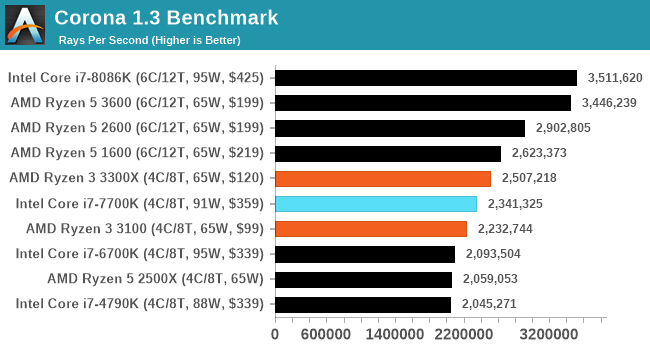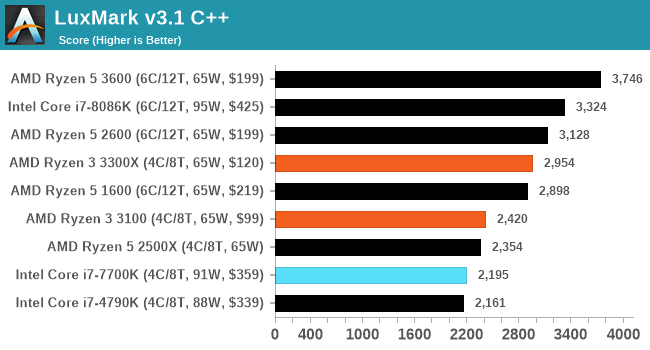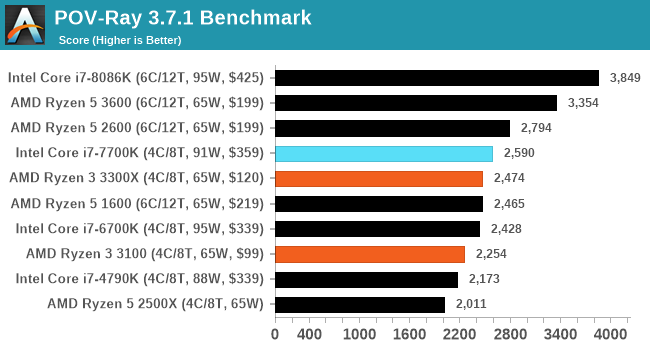The AMD Ryzen 3 3300X and 3100 CPU Review: A Budget Gaming Bonanza
by Dr. Ian Cutress on May 7, 2020 9:00 AM ESTCPU Performance: Rendering Tests
Rendering is often a key target for processor workloads, lending itself to a professional environment. It comes in different formats as well, from 3D rendering through rasterization, such as games, or by ray tracing, and invokes the ability of the software to manage meshes, textures, collisions, aliasing, physics (in animations), and discarding unnecessary work. Most renderers offer CPU code paths, while a few use GPUs and select environments use FPGAs or dedicated ASICs. For big studios however, CPUs are still the hardware of choice.
All of our benchmark results can also be found in our benchmark engine, Bench.
Corona 1.3: Performance Render
An advanced performance based renderer for software such as 3ds Max and Cinema 4D, the Corona benchmark renders a generated scene as a standard under its 1.3 software version. Normally the GUI implementation of the benchmark shows the scene being built, and allows the user to upload the result as a ‘time to complete’.
We got in contact with the developer who gave us a command line version of the benchmark that does a direct output of results. Rather than reporting time, we report the average number of rays per second across six runs, as the performance scaling of a result per unit time is typically visually easier to understand.
The Corona benchmark website can be found at https://corona-renderer.com/benchmark

LuxMark v3.1: LuxRender via Different Code Paths
As stated at the top, there are many different ways to process rendering data: CPU, GPU, Accelerator, and others. On top of that, there are many frameworks and APIs in which to program, depending on how the software will be used. LuxMark, a benchmark developed using the LuxRender engine, offers several different scenes and APIs.
In our test, we run the simple ‘Ball’ scene on both the C++ and OpenCL code paths, but in CPU mode. This scene starts with a rough render and slowly improves the quality over two minutes, giving a final result in what is essentially an average ‘kilorays per second’.

POV-Ray 3.7.1: Ray Tracing
The Persistence of Vision ray tracing engine is another well-known benchmarking tool, which was in a state of relative hibernation until AMD released its Zen processors, to which suddenly both Intel and AMD were submitting code to the main branch of the open source project. For our test, we use the built-in benchmark for all-cores, called from the command line.
POV-Ray can be downloaded from http://www.povray.org/












249 Comments
View All Comments
BenSkywalker - Friday, May 8, 2020 - link
You just called them AMD shills. They went into this review to prove how great AMD is, that is not journalism, that is not a review, that is a marketing campaign.Literally zero need to use the CPU bench tool they have, literally every other site I've checked has a useful, much better review, although it doesn't hit the level of marketing you are looking for.
Spunjji - Monday, May 11, 2020 - link
"Openly stating the obvious conclusion that your empirical testing led you to is a marketing caompaign" is exactly the sort of anti-intellectual, brain-dead take I have come to expect from you, Ben.He didn't call them AMD shills - you did, and all for daring to have an opinion.
BenSkywalker - Friday, May 15, 2020 - link
"They try to make a point with their review"That is to the letter the opposite of objectivity, that is precisely what shilling is, and I'm not the one that said it. Is English not your first language? You truly shouldn't being up intellect if you don't comprehend the words being used.
Deicidium369 - Friday, May 8, 2020 - link
is it any different that the AMD Fluff like "Which is the best CPU" "Which is the best Workstation CPU" etc ...Spunjji - Monday, May 11, 2020 - link
How was that article "AMD fluff"?Oh, because Intel's offerings got panned. How sad. I guess that means Anandtech has a bias that tracks roughly with which parts are the best at any given time. Its almost like... objectivity 🤔
PeterCollier - Monday, May 11, 2020 - link
I agree. Ian should take some classes from Andrei on chart creation and proper benchmarking.Fataliity - Friday, May 8, 2020 - link
The first page talks about,Which should you buy? the 3100/3300 versiohns, or a 2600, or a 1600AF?
And then the benchmarks compare them.
He's comparing what you can buy in the price range, I thought it was easy to understand.
BenSkywalker - Friday, May 8, 2020 - link
The world does not revolve around what amdownzjoo.com has as a recommended processor. Even if we were limiting ourselves to that, what about the 3200G? Every other site I found handled their reviews of this product much better.Spunjji - Wednesday, May 13, 2020 - link
What *about* the 3200G? It's an older, slower CPU. If you're going to add a dGPU, it's pointless. If you're not, you're still better off waiting for the 4000 series.The desperate scraping for even a semblance of a point in your posts is positively painful.
BenSkywalker - Friday, May 15, 2020 - link
Wanting to see how a $99 CPU compares to a $99 and a $129 CPU is pointless..... You have a special way of viewing things.